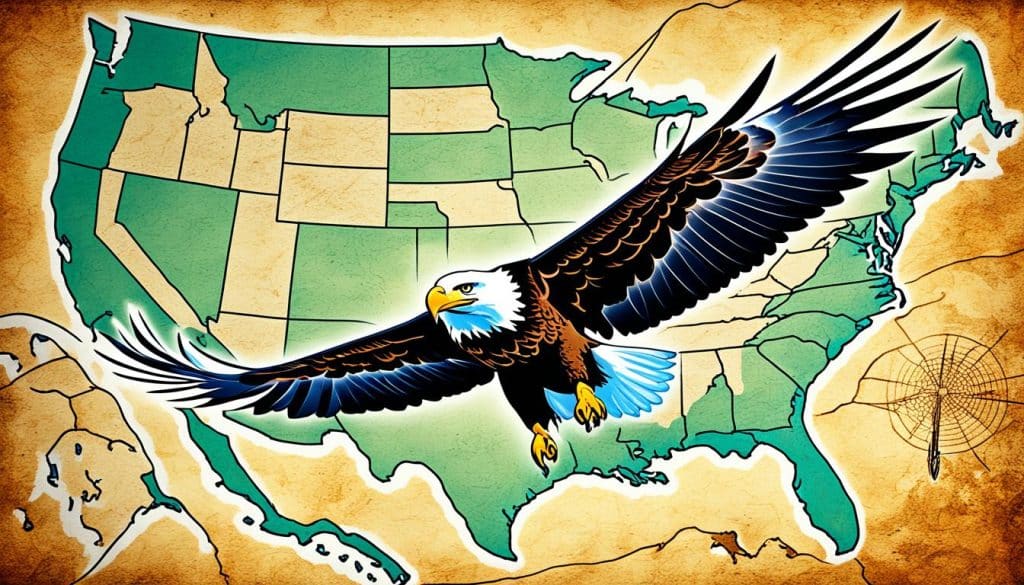UK businesses looking to grow might find the US market potential very appealing. The USA is a big market that could bring many benefits to those ready to take on the challenge. But, there are also downsides like cultural differences, complex rules, and tough competition that could slow them down. It’s important to know both sides to make smart choices about growing in America.
Key Takeaways
- The USA offers significant US market potential for UK businesses.
- Understanding cultural differences is crucial to navigating the US business landscape.
- Identify both the advantages of expanding into the USA and the potential risks involved.
- Regulatory challenges may pose disadvantages of expansion.
- Competitiveness in the US market necessitates effective differentiation strategies.
Understanding the US Market
The US market is unique and appealing for businesses wanting to grow. It’s key to know about consumer types, regional differences, and the big spending power here. This knowledge helps in making strategies that really work.
Key Characteristics of the US Market
American shoppers have many different tastes, which change a lot by region. These changes come from things like culture, economy, and social life. Knowing these regional differences is vital for companies aiming to enter this big market.
The US is known for its strong buying power, with many people having extra money to spend. This means businesses need to really understand who they’re selling to. They should look at things like age, race, and how much money people make when making products and marketing them.
| Demographic Factor | Impact on Consumer Behaviour |
|---|---|
| Age Group | Different age groups show varied preferences for products, from tech gadgets to wellness services. |
| Income Level | Higher income brackets tend to prioritise quality and luxury brands, influencing purchasing decisions. |
| Ethnicity | Ethnic diversity shapes food preferences, fashion choices, and media consumption habits. |
| Geographic Location | Regional differences in the US lead to distinct market demands; for example, outdoor products may be more popular in mountainous areas. |
The Economic Landscape of the USA
The US economy is a key player worldwide, known for its varied industries. This part looks at the main sectors that drive growth in the US. It also talks about the key signs that show how business is doing in the USA.
Major Industries and Economic Drivers
Important industries are the heart of the US economy. They greatly affect its strength and growth. Here’s a look at these vital sectors:
- Technology: The tech sector is huge, thanks to Silicon Valley. It’s all about new ideas, software, and IT services.
- Finance: Finance is big, with Wall Street at its core. It offers everything from investment banking to managing assets.
- Healthcare: Big names like Johnson & Johnson and Pfizer make healthcare crucial to the economy.
- Consumer Goods: Companies like Procter & Gamble shape the consumer goods sector, touching our daily lives.
Looking at economic signs like GDP growth and job rates helps us understand the US business scene. For example, the economy is slowly getting back on track after the pandemic. Different sectors are adjusting to the new normal.
| Industry | Contribution to GDP (%) | Key Companies |
|---|---|---|
| Technology | 10.5 | Apple, Google, Microsoft |
| Finance | 7.2 | Goldman Sachs, JP Morgan Chase |
| Healthcare | 9.5 | Pfizer, Johnson & Johnson |
| Consumer Goods | 4.8 | Procter & Gamble, Coca-Cola |
These major industries together shape the US economy. It’s vital for foreign businesses to keep up with trends and changes. This helps them understand the US market better and use the growing economy to their advantage.
Advantages and Disadvantages of a Business Expanding into the USA

Entering the US market offers both chances and hurdles for businesses. It’s key to know these points before deciding to expand. By looking at the good and bad sides, companies can make better choices.
Advantages of Expansion
- Access to a larger customer base, which significantly increases potential sales and market share.
- Higher sales volumes can lead to economies of scale, reducing cost per unit.
- The US environment fosters innovation, providing various resources and talent.
- Potential for greater brand recognition and reputation improvement.
- Robust infrastructure facilitates logistics and distribution, enhancing operational efficiency.
Disadvantages of Expansion
- Complex regulatory requirements can pose significant challenges of US market entry.
- Fierce competition requires businesses to invest in marketing and differentiation strategies.
- Cultural barriers may lead to misunderstandings and hinder customer engagement.
- High operational costs, including labour and real estate, can strain budgets.
- Market dynamics can be unpredictable, impacting long-term strategic planning.
| Advantages | Disadvantages |
|---|---|
| Greater market access | Regulatory complexities |
| Enhanced sales potential | Strong market competition |
| Innovative ecosystem | Cultural challenges |
| Brand visibility | Operational costs |
| Efficient logistics | Market volatility |
Regulatory Environment in the USA
Entering the US market means understanding the rules is key to success. The US has many laws at federal, state, and local levels. These rules can be quite different from what UK businesses are used to.
Legal Framework for Business Operations
The legal setup for doing business in the USA is complex. It covers many areas like taxes, jobs, health and safety, and patents. Each state has its own set of rules, making things even more complicated. UK businesses need to learn about these laws to stay within the law and avoid fines.
Compliance Challenges for Foreign Businesses
UK businesses face big challenges with US laws. Some common issues include:
- Licensing needs that change by state
- Complex tax rules at federal and state levels
- Labour laws that are different from the UK
Not following the rules can cause big legal problems for UK businesses. This can make it hard for them to succeed in the US market. Getting advice from legal experts in US business laws is very helpful. They can guide foreign companies through the complex US rules.
| Challenge | Detail |
|---|---|
| Licensing | Requirements differ state by state, complicating entry for businesses. |
| Taxation | Adhering to both federal and state tax laws can be intricate and daunting. |
| Labour Laws | Employment regulations may differ, affecting recruitment and workforce management. |
Market Competition in the USA
The US market is full of both chances and challenges for businesses looking to grow. Knowing how competitive it is is key. It helps shape the best way to enter the market. Looking closely at big companies and their ways of working shows what makes them successful.
Competitive Landscape Analysis
The US market is filled with both big companies and quick-moving startups. Different industries have different levels of competition. Some have lots of rivals, while others have a clear leader.
Doing a deep analysis of the competition in the USA means finding out who the main competitors are. You need to know their market share, who buys from them, and their strategies. This helps new companies know where they fit in.
Strategies to Differentiate Among Competitors
To stand out, UK businesses should think about new marketing ideas and forming partnerships. Some key strategies include:
- Creating a special offer for US customers.
- Using technology to better connect with customers and make things smoother.
- Working with local companies to gain trust and learn more about the market.
- Using data to target marketing more effectively.
By using these strategies, companies can deal with the competition in the US market well. They can turn possible threats into good chances.
| Industry | Key Competitors | Market Dynamics |
|---|---|---|
| Technology | Apple, Google, Microsoft | High competition with rapid innovation |
| Retail | Walmart, Amazon, Target | Price wars and customer loyalty focus |
| Healthcare | UnitedHealth, CVS Health, Anthem | Regulatory challenges and quality competition |
| Finance | JP Morgan Chase, Bank of America, Wells Fargo | Service differentiation and digital banking trends |
Consumer Behaviour Trends in the USA

For businesses wanting to enter the American market, it’s key to understand US consumer behaviour. Cultural influences, tech growth, and economic factors affect how people shop in the USA. Knowing these trends helps UK businesses make their strategies fit local tastes.
Understanding US Consumer Preferences
Shopping habits in America have changed a lot lately. More people now prefer shopping online for ease and a wider choice. The pandemic made online shopping even more popular, making e-commerce a big deal. Companies need to keep up with these changes to stay ahead.
Now, many Americans care a lot about the environment, which affects what they buy. They look for products that are good for the planet. Brands that focus on being eco-friendly and open about where they get their materials get more loyal customers.
There’s also a big push for buying local products. People want to support shops in their area. This means foreign businesses should think about working with local suppliers. Knowing what US consumers like can help UK businesses plan their entry into the market.
Tax Implications for UK Businesses
Expanding into the US offers many chances for UK companies, but it also means dealing with specific tax issues. It’s vital to grasp the US tax system for businesses for good financial planning. This part looks at tax duties, like corporate taxation in the USA, income taxes, and sales taxes, that UK businesses might face.
Overview of US Tax Requirements
The US has various tax structures for UK companies to understand. Important taxes that might apply include:
- Corporate Income Tax: This federal tax is on net income, usually at 21%.
- State Taxes: Companies might face extra income taxes, which vary a lot by state.
- Sales Tax: A tax on sales that changes by state and local area, affecting prices of goods and services.
UK companies should think about double taxation treaties between the UK and the USA too. These treaties help prevent income from being taxed twice, which can lower the tax load. Good tax planning is key to cutting down on taxes and following the US tax rules for businesses.
Knowing the tax scene and preparing well helps UK businesses succeed in the US market. It’s smart to talk to tax experts who know both UK and US tax laws to handle these issues well.
Accessing Funding and Investment Opportunities
Getting funding is key for UK businesses wanting to grow in the US. There are many funding options available, each with its own benefits. Knowing about these can help UK businesses find the right support for their move into the USA.
Types of Funding Available
Businesses have several funding sources to choose from for their growth. Here are some common ones:
- Venture Capital in the USA: This is a top choice for start-ups and companies that are growing fast. Venture capitalists give money and advice in exchange for a share of the business.
- Angel Investing: Angel investors are people who give money to new businesses. This funding is usually for the early stages and is crucial for quick growth.
- Bank Loans: Banks are a traditional funding option. UK businesses need a strong business plan and to show they can make a profit to get a loan.
- Government Grants and Incentives: The US government has programmes to help foreign investors. These grants support certain industries or projects, helping businesses take on the risks of expanding.
These funding sources give UK businesses many options when they want to grow in the US. Knowing about the funding options helps them build a strong base as they enter a new market.
| Type of Funding | Advantages | Considerations |
|---|---|---|
| Venture Capital | Access to large amounts of capital; expertise from investors. | Equity dilution; expectations for rapid growth. |
| Angel Investing | Flexible terms; industry connections. | Potential for high-interest rates; reliance on personal wealth. |
| Bank Loans | Retain full ownership; predictable repayment terms. | Strict eligibility criteria; may require collateral. |
| Government Grants | Non-repayable funds; support for specific projects. | Competitive application process; often limited to certain sectors. |
Cultural Differences and Their Impact

For UK businesses going into the American market, knowing about cultural differences is key. The US and UK have different ways of communicating and making decisions. This knowledge helps UK businesses fit in and work better with Americans.
Navigating Cultural Nuances
In America, work culture values being direct and focusing on the individual. This is different from the UK’s team-focused approach. Americans like to take charge and be responsible for their work. This means UK managers and workers need to change how they manage and talk to each other.
- Communication Style: Americans like to talk straight and honestly. This is unlike the British preference for being subtle. Being clear and open in talks helps build better relationships.
- Time Orientation: Being on time is very important in the US. Keeping to deadlines and planning meetings carefully shows respect for people’s time.
- Professional Relationships: While UK people may take time to get to know each other, Americans aim to make connections quickly. Joining in on casual chats or networking can lead to valuable contacts.
Adjusting to these cultural differences makes working with Americans better. It also makes UK businesses more successful in the US. By understanding and valuing American ways, UK companies can move through the American market more smoothly.
Technology and Innovation in the US Business Sector
In today’s fast-changing market, tech trends in the USA are key to business success. Companies in many sectors are using new ways to work better and stay ahead. For UK businesses thinking of growing in America, it’s vital to understand this shift. Innovation in American business means more than just new products. It’s about new ways of doing things that make companies more efficient and profitable.
The Role of Technology in Business Growth
Technology is crucial for modern business plans. It helps companies work better and quickly adapt to changes. Top companies use tech to improve how they talk to customers and manage resources well. They focus on several key areas:
- Automation and AI: Companies use AI and automation to increase productivity and cut costs.
- Data Analytics: By using data analytics, firms can understand what customers want, making better decisions and marketing.
- Cloud Computing: Cloud solutions help businesses work together better, grow easily, and keep data safe.
- E-commerce Integration: With more people shopping online, companies need to use e-commerce to reach more customers.
UK businesses entering the US market should be proactive with their tech use. Adopting these tech trends helps them work better and stand out in the competitive field.
Potential Risks of Expansion
Expanding into the US market comes with many potential risks. These risks can greatly affect the success of the expansion. Knowing about these risks is key to managing risks well.
Identifying and Mitigating Risks
Businesses face several critical risks when they enter the US market. These include:
- Market volatility: Economic ups and downs can hit business hard.
- Legal risks: It’s vital to know and follow the many laws across states.
- Competition-related challenges: The US market is very competitive, so standing out is crucial.
These risks are part of the bigger picture of business expansion risks. To overcome these, companies need strong risk management strategies. Some ways to do this include:
- Doing deep market research to grasp local conditions.
- Identifying specific risks in the target market through risk assessments.
- Creating backup plans for different possible situations.
Working with local experts and using their knowledge can give companies an edge in the US market.
| Risk Type | Impacts | Mitigation Strategies |
|---|---|---|
| Market Volatility | Potential revenue loss | Develop flexible pricing strategies |
| Legal Risks | Fines or operational setbacks | Consult legal experts familiar with US laws |
| Competition Challenges | Decreased market share | Focus on unique selling propositions |
Knowing the risks of entering the US market is a big step. With the right strategies for managing risks, businesses can set themselves up for success.
Success Stories: UK Businesses in the USA
The journey of successful UK businesses in the USA is full of lessons for those looking to expand. We’ll look at some case studies that show how these companies overcame challenges and found opportunities in the American market. These stories can guide others who want to enter the market.
Case Studies of Successful Expansion
Many UK brands have done well in the US, showing that expanding across borders can work. Here are a few examples:
- Burberry: This luxury fashion brand made a big impact by changing its marketing to appeal to Americans. It kept its British roots but also adopted local trends, making its brand stronger.
- Barclays: The bank grew in the US by offering different financial services and making products that fit local needs. It used smart partnerships and acquisitions to deal with the complex US rules.
- ASOS: This online shop quickly became popular in the USA by focusing on making shopping easy and efficient online. It used technology to reach more people and grow fast.
These companies show the importance of adapting to local markets, knowing what customers want, and using technology to grow. Their stories can help UK businesses that want to succeed in the USA.
| Business | Strategy Employed | Outcome |
|---|---|---|
| Burberry | Marketing adaptation and localisation | Enhanced brand perception and increased sales |
| Barclays | Product diversification and partnerships | Established strong market foothold |
| ASOS | Optimised e-commerce platform | Rapid market penetration and growth |
Strategies for a Successful Expansion into the USA
Expanding into the US market needs careful planning and action. It’s key to have good strategies for entering the US market. Companies must grasp the US market’s unique traits and use successful business tactics to do well.
Key Steps for UK Businesses
Several important steps are vital for success in the US market:
- Thorough Market Research: Do deep research to learn about market trends, what consumers like, and who your competitors are.
- Establish Local Partnerships: Work with local businesses or experts who know the market well.
- Adapting Marketing Strategies: Adjust your marketing to fit what US consumers like, including their culture and values.
- Navigating Legal Considerations: Learn about US laws that apply to your industry and make sure you follow them.
- Developing a Customized Business Plan: Make a business plan that’s specific to the US market, outlining resources and goals.
These steps help increase the chances of success in a new market. They also shape effective strategies for entering the US market. By using successful business practices and improving their market entry strategies, UK businesses can make a strong mark in the USA.
| Step | Description | Importance |
|---|---|---|
| 1. Market Research | Getting insights into the market and how consumers behave. | Key for making informed choices. |
| 2. Local Partnerships | Working with established groups for an easier entry. | Offers valuable local insights and trust. |
| 3. Marketing Adaptation | Adjusting messages for the US audience. | Helps connect with consumers better. |
| 4. Legal Navigation | Understanding and following local laws. | Reduces risks and boosts security. |
| 5. Business Plan Development | Creating a plan specific to the US market. | Directs strategic moves and how to use resources. |
Summary and Conclusion
This article looks at how UK businesses can expand into the US market. It covers the good and bad points of entering this market. The main benefits include a large customer base and modern infrastructure. However, there are challenges like complex rules and tough competition.
Understanding the US market is key to success. This means looking at things like who buys things, how they act, and the economy. The article offers tips on how UK businesses can fit into the American market. It suggests adapting to local tastes and rules.
When thinking about entering the US market, careful planning is essential. A good plan should tackle both the chances and the risks. Staying updated with new trends is also crucial for long-term success in the US.
Further Resources and Reading
UK businesses thinking about entering the US market have many resources to help them. The UK Department for International Trade offers valuable insights and specific help for UK businesses in America. They provide important statistics, success stories, and advice for different industries.
There are also many industry reports and articles on entering the US market. You can find these on the British Chambers of Commerce and other trade groups. These articles talk about the challenges and chances in various sectors. They give businesses the knowledge they need to make smart choices.
Comprehensive guides for expanding into America are also available from top consulting firms. These guides give step-by-step advice and best practices. They cover operational details, cultural differences, legal needs, and tech changes that could affect your business. Using these guides, UK businesses can greatly improve their chances of doing well in the US market.
















